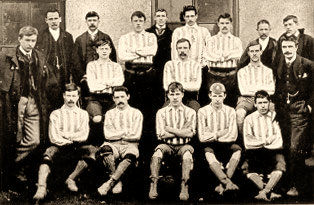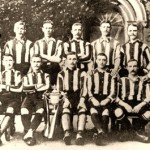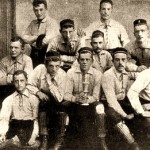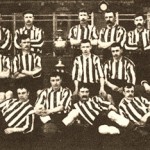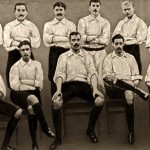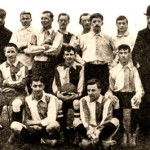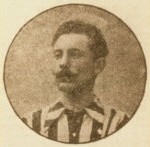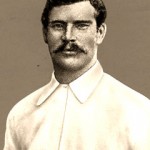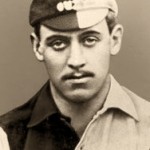CURIOSITIES OF WORLD FOOTBALL (1891-1900)
Picture : Celtic Glasgow 1891
- Notts County 1894
- Akademisk BKK 1894
- Sunderland AFC 1895
- Örgryte IS Göteborg 1896
- Genoa CAF 1898
- Havre AC 1899
- Gustave Pelmgrims
- James Trainer
- William John Oakley
1891
22 Scots win the Argentine championship
The first Argentine championship, which was held in 1891, had two winners: Saint Scotch Athletic Club and Old Caledonians FC (Buenos Aires). Both sides, including reserve players, consisted entirely of Scots. The team of the English champion of the year 1891 Everton counted four Scottish regular players and five reserves, and three Scots were the dominant figures in the team of Irish champion Linfield. Since Scotland also had two champions this year (Dumbarton and Glasgow Rangers), which of course consisted entirely of native players, this was truly a masterly year 1891 of the Scotsmen.
1891
Irishman scores 10 goals in a cup match
During the third cup round, Ulster FC (Belfast) beat Milltown 16:0 on November 7, 1891. Robert McIlvenny scored ten goals, an Irish Cup record which stands to this day. He scored another three during the 1891/92 Irish Cup season, but in the semi-finals Ulster FC were eliminated by local rivals Linfield (0:3).
1891
Two champions, but only for one team medals
When the first Argentine championship was played in 1891, it ended with two teams topping the table level on points. “The Argentine Association Football League” (AAFL) had forgotten to draw up rules to determine a champion in such a case. The AAFL declared both teams the winners, but then did not have the money for two sets of winners’ medals. Thus a play-off between both champion teams was ordered to determine which of the two sides would receive the medals. Saint Andrew Scotch AC beat Old Caledonians FC (Buenos Aires) 3:1 to earn the medals.
“The Scottish Football Association” (SFA) also had likewise overlooked this eventuality when the first Scottish championship was played during the 1890/91 season, also in a league system. At first it ordered a play-off between the two teams which headed the table and were level on points, Dumbarton FC and Glasgow Rangers FC. When the play-off ended a draw (2:2), the SFA was at the end of its wits and declared both teams the winners.
One year later, the DBU league season ended with three teams topping the table together. The Danish FA ordered no play-offs and did not declare any team the champions. Thus, the 1891/92 season in Denmark had three actual winners, but no champions.
The English were the first to use goal average for promotion and relegation of teams as well as for championships.
1892
Famous musician, top scorer and national player
The centre forward John Southworth (12.12.1866-16.10.1956) of Blackburn Rovers was English top scorer with 26 goals in the season 1890/91 and world best first-division gal scorer as well. Earlier that year, he had won the “English Cup” with the “Rovers”. When on April 2, 1892, England were British champions again after beating Scotland 4:1 in Glasgow, it had been “Jack” Southworth’s third full “A” international. Yet his greatest passion was music, even more than football. He was a musician by profession and played in the famous “Hallé Orchestra”.
1892
English superiority or arrogance?
After having done so on March 15, 1890, and March 7, 1891, on March 5, 1892, for the third and last time during the 19th century, England fielded two “A” national teams – who had equal rights – on the same day. They played against Ireland and Wales respectively, and won both full “A” internationals. In five of these six matches, the English side consisted of professionals and amateurs. The opponents were unhappy at England playing two full “A” international on the same day, but the results suppressed all counter-arguments.
1893
Head doctor sets two world records
First the most first-division matches notched up in the 19th century as both player and coach go to the credit of Holger Forchhammer of Denmark, who was with Akademisk Boldklub København. From 1889-1893, he played in 22 matches and coached his side in the same 22 besides. Furthermore, he also refereed 11 first-division matches. This triple function as player, coach and referee with total of 55 appearances was a world record in the 19th century. During the summer of 1893 he left Copenhagen, having finished his study of medicine, to take up his internship at a province hospital. He later returned to Copenhagen, where he worked as the head doctor of a large hospital. His brother Johannes Forchhammer won in the 19th century the Danish championship six times with the same club – also a world record.
1893
Welsh international faster than English 100 yards sprint champion
On March 18, 1893, playing in Wrexham, Wales lost to Scotland by the sensational score of 0:8. Yet Welsh centre half-back Edwin Hugh Williams (1868-14.5.1950) was very strong, agile and could run like the wind. At a race beat at one time the English champion of the 100 yards sprint. He was a journalist by profession. His footballing career was cut short by a torn ligament in December 1894.
1893
Excluded from the national league for not paying the fee
In addition to the five Belfast clubs, Derry Olympic also took part in the Irish league championship. Derry Olympic was not a club in the usual sense, but a selection of the best players from Londonderry County. The deadline for paying the league fee was November 26, 1892. When Derry Olympic failed to pay the fee by this date, the “Irish Football Association” (IFA) excluded them from the league matches on December 3, 1892, and awarded their remaining, still unplayed league matches to their opponents.
1894
Football career cut short by church service
The top scorer of the Danish 1893/94 season, Karl Gadegaard, attended the seminary at Copenhagen University, and so also played for Akademisk Boldklub. Until the early 1950’s, all students and academic staff at the university were categorically required to play for this club. Dubbed “Pfarrer” (Preacher) by his team-mates and others as well, he scored almost one goal per match. When he graduated in 1896, he had to give up football since matches in the Danish league kicked off between 11:00 and 14:00 o’clock, the same time as the Sunday church service.
1894
The first second-division club in the world to become national cup winners
The year 1894 saw the hitherto biggest sensation in English Cup history. Second-division side Notts County not only reached the final, but also won the trophy after beating Bolton Wanderers 4:1. The “Trotters” had fielded five Scots for the final, winners “Magpies” four. Both sides were captained by a foreigner: Notts County by David Calderhead from Scotland, and Bolton Wanderers by David Jones from Wales. By the way was not held championship in Wales and in the “Welsh Cup” also took part English clubs from the lower divisions
1894
English amateurs not worse than professionals, and held in higher regard
Professional football was legalised in England in 1885. But, barring a few exceptions, England continued to field amateurs in the national team during the 19th century. On March 12, 1894, when they beat Wales 5:1 in Wrexham, England had – as always prior to 1885 – fielded an all-amateur side. Ten years after professional football was legalised in England, there still was no noticeable difference in performance between top professional and amateur players. The reason was that there still were too many first-rate players who, for some reason or other, chose to remain amateurs, and also had the means to train like porfessionals. Also, the public in the 19th century still held amateurs in much higher regard than professionals.
1894
A first-division world record: 22:0
The highest first-division league score in the world since 1888 was achieved on October 29, 1893, when Akademisk Boldklub (AB) København beat Boldklubben Arrow København 22:0. The Danish club “AB” thus set the 13th world record in this category.
1894
A goal difference of +7 and –7 both in the same week
Eighth-placed Dundee FC figured in both the highest win and the heaviest defeat of this Scottish first division season. On February 10, 1894, they beat Renton FC (8:1), and one week later lost to St. Mirren in Paisley (3:10).
1895
Welsh, Scots and Irish outperform the English
The first national championship in England was contested by 12 teams in 22 league matches. However, the only ones to play in every league match during the first three seasons were the Englishmen Edgar Wallace Chadwick (Everton FC) and Thomas Pearson (West Bromwich Albion FC). For the next season, 1891/92, the league was expanded, and they were surpassed by Welsh national team goalkeeper James “Jim” Trainer (Preston North End FC), who raised the mark to 162 consecutive first-division matches, thus also setting a 19th century world record. In 1900, Archibald “Archie” Freebairn of Scotland (136 / Bolton Wanderers FC) and Archibald Lee Goodall of Ireland (135 / Derby County FC) occupied ranks 2 and 3 behind him.
1895
English international and long jump champion
The England side which played Wales in London on March 18, 1895 (final score 1:1) consisted entirely of amateurs. Left full-back William John Oakley (27.4.1873-20.9.1934) from the Oxford University Athletic Club, a football acrobat, was English long jump champion in 1894, and in 1895 was a hurdler on the English national track-and-field team (against the USA). He also was a member of the Oxford eight (rowing) in 1894. The teacher died from the injuries of a traffic accident.
1895
Two doctor brothers in the Irish Cup final
1895 was the first time that a Dublin club reached the Irish Cup final. The “Bohemians” side included no fewer than four players with an academic degree: Dr. Joseph Whelan, Dr. John Blayney, Dr. John Murray, and Dr. Robert Murray. The latter two were brothers. “Bob” Murray played in defence, “Jack” Murray was inside left. The super-intelligent team, as they were known, opened the score after 30 minutes through Dr. John Blayney, but Linfield, including Irish internationals, were vastly superior, and won the match 10:1, the first and only double-digit victory in a national cup final worldwide in the 19th century. IQ isn’t everything in football.
1895
English champion with ten Scots on the squad!
When during the 1894/95 season Sunderland AFC became English champions for the third time, their regular squad included only one Englishman (inside right William Dunlop). All the other players were Scots. Even the six reserve players who were occasionally called up included five Scots. The regular “Rokerites” line-up was: John Edward Doig – Peter Meechan, Robert McNeil – Hugh Wilson, Andrew McCreadie, Harry Johnston – James Gillespie, William Dunlop, John Middleton Campbell, James Millar, James Hannah.
This was not, however, a world record for when Saint Andrews Scotch AC played off against Old Caledonians FC (Buenos Aires) during the Argentine championship in 1891, all 22 players were Scots! When Preston North End FC won the English championship in 1888/89, seven foreigners were titulars, and when the “Lilywhites” successfully defended their title the next season, nine of their regular players were foreigners.
Thus, the high proportion of foreigners in club sides which so many complain about today already existed over a hundred years ago, and it was far worse back then.
1895
World record holder, but failed in life
James Trainer, who played for Preston North End (PNE) from 1887 to 1899 (253 first-division matches) and 20 times for Wales, was an eccentric and unpredictable goalkeeper. Many considered him the best goalkeeper in the world in his epoch, and he won several national titles with PNE. He also held two world records: He was the goalkeeper who stayed unbeaten for the longest time, and also the one who stayed unbeaten in the most first-division league matches. However, “the Prince of Goalkeepers”, as he was known, could not get his private life in order. In 1904 he simply left his wife and ten (!) children, became increasingly isolated and died utterly destitute in Paddington (London) on August 5, 1915, at the age of 52.
1896
Argentine champion runs out of players
Lomas Academy were Argentina‘s surprise champions in 1896. During the next season, however, they were forced to withdraw shortly after the league kicked off as three of their players left the educational esrablishment after finishing their studies, another two continued theirs in Europe, and three quit football altogether to concentrate on academics. Suddenly finding itself eight regulars short, the team dropped out of the tournament. Hard to believe, but true.
1896
Swedish football and high jump champion almost on the same day
Playing in Hälsingborg (now Helsingborg), right half-back Nils Ericsson won the first Swedish championship with Örgryte IS (Göteborg) in August 1896. During that time in Hälsingborg, he also became the Swedish high jump champion (1.58 m), because the national track-and-field championship was held with the national football championship.
1896
Two balls in play, and lost 0:1
The first Belgian league championship was played during the 1895/96 season. At the foot of the table Union FC Ixelles won their only victory in rather curious fashion. Hosts Racing Club de Bruxelles were (on the November 24, 1895) so overwhelmingly superior that their goalkeeper Gustave Pelgrims and one of the full-backs, feeling somewhat redundant, started kicking around a spare ball, much to the amusement of the spectators. Being thus occupied, they were caught unawares when a powerful kick – and the strong back wind – carried the ball from a conserable distance straight into the net of Racing Club. The outsiders won a sensational 1:0 victory, thus also relegating Racing Club down to fourth place.
1897
Higher fees, fewer protests
Prior to the beginning of the second Belgian league championship, in 1896/97, the “Union Belge des Sociétés de Sports Athlétiques” ruled that clubs were to pay a fee of 20 francs when submit a protest in writing. This promptly led to a 90% drop in protests and complaints. It is hard to believe how effective fees and fines were back then.
1897
Two brothers in step: national players, priest, minister
On March 6, 1897, when Ireland beat Wales in Belfast (4:3), the Irish team included the brothers James Pyper (18.4.1876-5.3.1925) and John Stanley Pyper (9.1.1878-6.8.1952), who at the time were studying theology to become priests. The older brother, “Jim” Pyper, a centre forward, would later become a minister with the Duncairn Presbyterian Church (Belfast). His younger brother “Jack” became a minister with the Strand Presbyterian Church (Portstewart). “Jim” und “Jack” Pypers had already made a name for themselves while playing in attack for Cliftonville FC (Belfast).
1898
Sheffield United: Lords of the Draw
No team drew more matches in sequence during the 19th century than Sheffield United FC, who in 1897 became the first club in the world to draw four consecutive first-division matches, and in 1898 drew five in a row. They also had three runs of three consecutive league draws each. For the record, the first top-division draw came on September 8, 1888: Wolverhampton Wanderers FC 1:1 Aston Villa FC.
1898
Only 2-4 hours between the national semis and the final
When the first national championship in Italy was played in 1898, on May 8th of that year, the two semi-finals were played back to back in the Velodromo “Umberto I” starting at 9:00 a.m., the final then following at 15:00 on the same day. This match even went into extra time (two times 10 minutes) before Genoa Cricket and Athletic Club prevailed over Foot-Ball Club International Torino (2:1). Both sides counted five foreigners each.
1898
Swedish champion – in football and the 1,500 m and 10,000 m race
When in 1898 Örgryte IS (Göteborg) won the Swedish championship for the third consecutive time, their right full-back was Paul M. Pehrson. He also was an outstanding athlete, and in 1896 was the Swedish champion over 1,500 m and 10,000 m. By the turn of the century (1900), an unusually high number of Swedes were universal sportsmen and belonged to the national elite in several different kind of sports.
1899
Record series: 34 league matches without a loss, 25 league matches without a win
Preston North End FC (PNE) set an international first by staying undefeated in 23 consecutive matches starting with day 1 of the English league (1888/89). Three years later, PNE held out for 15 matches, but in 1896 were surpassed by Argentine champions Lomas Athletic Club, who went undefeated for 29 consecutive first-division matches. Their record was then broken in December 1899, when Glasgow Rangers FC played 34 first-division matches without a defeat. The negative 19th century record, on the other hand, was held by a Scottish team from Dumbarton, Vale of Leven Alexandria who played 25 first-division matches in a row (1891-1892) without winning one. Six years later, Banfield Athletic Club of Argentina reached a new low by going through 24 first-division matches without a win.
1899
Danish power
Akademisk Boldklub of Copenhagen was the first club in the world to be national champion four, then five, and then six times. Local rivals Kjøbenhavns Boldklub, for their part, were the first club in the world to be national vice-champions three, then four, and then five times – and all this during the 19th century.
1899
Switzerland says no to corporate advertising
With the support of French champagne firm Ruinart, the Geneva-based paper “Suisse Sportive” held a Swiss championship, which Grasshopper Zürich won by beating La Châtelaine in Geneva on March 19 and April 4, 1898 (6:1 and 2:0). However, this was not an official championship as it was not held under the auspices of the Swiss FA [“Schweizerische Football-Association” / “Association Suisse de Football” (SFA)], founded in Oten on April 7, 1895). One month after the second match, the SFA delegates declined to take over the “Challenge Ruinart”, as they did not wish to advertise for either Swiss or foreign companies.
1899
One poster per spectator
On April 16, 1899, Genoa Cricket and Foot-Ball Club met Foot-Ball Club Internazionale Torino in the final of the Italian championship on the Ponte Carrega ground in Genoa (final score 2:0). The hosts spared no expenses and had 200 posters affixed all over town. Even so, fewer than 200 spectators came, making an average of less than one spectator per poster. Still, at least the trophy stayed in Genoa.
1899
Hockey players cause only one half of the French semi-final to be played
On February 22, 1899, only one half of the national semi-final between Havre Athletic Club and Iris Club Lillois could be played in Paris. First, kick-off was delayed when no ball could be found, and much time was lost until another was brought. The hockey players who had made the booking for the Parc des Princes insisted on starting their match on time. Le Havre were leading 1:0 at the end of half-time, and Lille did not appear for the replay in Amiens.
1899
One goal per spectator
During the start of the second-leg round of the Belgian championship in 1898/99, the later runners-up Racing Club – who were short-handed, having only fielded a side of ten – lost the Brussels derby 0:3 to Athletic and Running Club. Due to the positively foul weather, only three (!) spectators had turned out for the match, which gives this encounter an average of one goal per spectator.
1900
Playmaker most succesful first-division goal scorer in the 19th century, but English musician the most effective
The top goal scorer in the first division (worldwide) of the 19th century after the 1899/1900 resp. 1900 season was the captain and playmaker of superteam Aston Villa FC, inside right John Henry George Devey, who still was active at the time and scored 153 goals in 241 first-division matches (average of 0.63 goals per match). Right behind him comes English super-scorer Stephen “Steve” Bloomer, with 138 goals in 216 first-division matches (average of 0.64 goals per match), and after him the then no longer active Englishman John Southworth (Blackburn Rovers FC, Everton FC) and Scotsman John Middleton Campbell (Sunderland AFC, Newcastle United FC), both of whom scored 133 first-division goals. While Campbell of Scotland played 188 matches, to an average of 0.71 goals per match, the English musician Southworth played only 139 matches, to the fantastic average of 0.96 goals per match. In fifth place comes James Donaldson Ross, another Scot, who played for four English clubs (Preston North End FC, Liverpool FC, Burnley FC, Manchester City FC), scoring 123 goals in 224 first-division matches, but occasionally also played in the second division. The most successful scorer of the first ten seasons in the Scottish top division was Alexander “Duke” McMahon (Glasgow Celtic), who scored 103 goals in 134 matches (average of 0.77 goals per match).
1900
The heaviest of the best
Scottish goalkeeper John Edward “Ned” Doig, who played in the English top division for Blackburn Rovers FC and, above all, for Sunderland AFC, set a 19th century world record by not conceding any goals in 87 of his 290 top division appearances (30%). James Trainer of Wales, who played for Preston North End FC, held the previous record, with 80 of 253 matches (31.6%). William Henry “Tiny” Foulkes (Sheffield United FC) of England, by far the world‘s heaviest goalkeeper ever in any first division, managed not to be beaten in 47 of his first 181 top-division matches (26%) until the end of the 1899/1900 season.
1900
Englishman becomes Belgian champion in football, hurdling, high jump and long jump
Racing Club de Bruxelles became Belgian champions for the second time after 1897 when they won the play-off against Antwerp FC (1:0) at the end of the 1899/1900 season. Their English centre forward and goalgetter Charles Grimshaw also was an excellent track and field athlete. In 1900 he was Belgian champion in 110 m hurdles, long jump (5.54 m) and high jump (1.58 m). His fellow forward Frank König, a Swiss, was Belgian champion of the quarter-mile race.
1900
Prime minister of Scotland cashes in on international matches
Scotland won the British Championship by beating England 4:1 at Celtic Park (Glasgow) on April 7, 1900, before a crowd of 63,000. As it was, the “Scottish Football Association” (SFA) had to pay a copyright fee to sporting peer Lord Rosebery (later prime minister) because the Scottish jerseys showed Rosebery’s horse racing colours.
